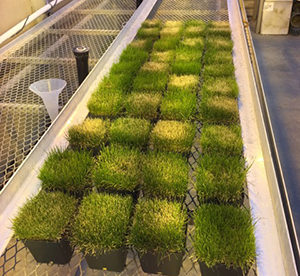Ryegrass injury and recovery from human insect repellent

Visible differences in turf injury at seven days after application. (Photo: Ross Braun, Ph.D.)
Superintendents commonly observe turfgrass injury from human insect repellent (bug spray) overspray on human skin and clothing. The injury most commonly occurs as an outline shape of unaffected footprints with damaged surrounding turf. This injury results in unacceptable turf quality.
Our project was to evaluate various human insect repellents on perennial ryegrass (Lolium perenne L.), and to determine injury and recovery. Research was initiated in 2016 and 2017 in greenhouses in Manhattan, Kan., on Paragon GLR perennial ryegrass. We applied nine aerosol insect repellents to perennial ryegrass to simulate a human standing on turf and applying insect repellent to the legs and feet.
In both years, all treatments except the nontreated control resulted in at least 6-percent turfgrass injury one day after treatment. We saw the most turfgrass injury from products that contained the active ingredient DEET. Products that contained DEET resulted in more turfgrass injury up to 28 days after treatment than picardian, IR3535 and geraniol plus soybean oil.
In 2017, at seven days after treatment, DEET products averaged 43-percent injury compared with 21-percent injury from non-DEET products. In 2017, turfgrass injury of 9 percent to 46 percent from all nine products was higher than the nontreated control at seven days after treatment, but perennial ryegrass recovered from all treatments thereafter.
Results indicated that insect repellent products differ in their injury to turf, and more information is needed on nontarget turf injury caused by human insect repellent overspray. Avoid overspray of aerosol insect repellents on perennial ryegrass turf because of their potential to cause turfgrass foliar injury.










